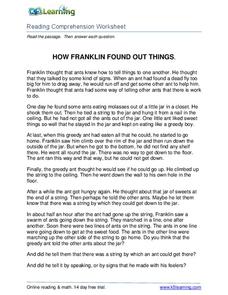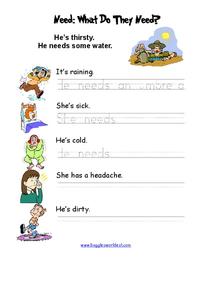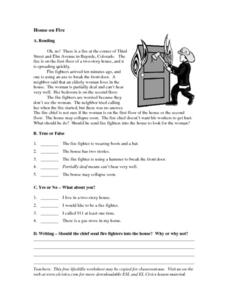It's About Time
Inferences of Waves
Building on the previous lesson, scholars use Slinkies to create standing waves. They graph waves on a calculator and then apply their knowledge to both sound and light waves. This is the fourth in a series of nine lessons.
Curated OER
Making Inferences: Scenario Worksheet
In this making inferences worksheet, students read 5 statements and they write what they can infer about each statement. Students make their own inference scenario and identify what they can infer from their scenario.
Curated OER
Pop Rock Chemistry
For this pop rock chemistry worksheet, middle schoolers suck on pop rocks, they mix open pop rocks with water and they observe them on a paper towel with water. Students write down as many observations as they can and they write down as...
Curated OER
Qualitative and Quantitative Observations
In this qualitative and quantitative observation worksheet, students determine if 10 given observations are quantitative or qualitative. They write a qualitative and quantitative statement and they write an observation and inference...
Curated OER
Big Bushy Mustache: comprehension skills
In this comprehension skills worksheet, students read the book Big Bushy Mustache and complete comprehension activities. Students complete 5 activities including note taking, making inferences, fiction and non fiction, drawing...
EduGAINs
Data Management
Using a carousel activity, class members gain an understanding of the idea of inferences by using pictures then connecting them to mathematics. Groups discuss their individual problems prior to sharing them with the entire class. The...
K5 Learning
Harry and Annie
Henry and Annie are on thin ice—literally! Read about the siblings' winter walk and the importance of staying safe with a short passage and four follow-up questions.
K5 Learning
How Franklin Found Out Things
Franklin learns about the world by making observations, and so do we! A short reading assignment prompts fourth graders to answer comprehension questions about a curious boy and what he notices.
Curated OER
Need: What do they need?
In this making inferences worksheet, learners make inferences and write sentences about what people need based on their picture. Students complete 4 sentences.
Curated OER
Just Let Me Draw
In this Just Let Me Draw worksheet, students read a one-page story about a student who loves to draw. Next, students answer a question that checks for comprehension, one that connects the story to their lives, and another that requires...
Curated OER
Present for Father
In this Father's Day worksheet, students read a passage about Father's Day and then answer 5 true or false questions involving inferences. Then the students write an opinion paragraph explaining what the girl should buy her father for...
Curated OER
House on Fire
In this reading comprehension worksheet about firefighting, students read a passage about firefighting, then answer 5 true or false questions using inferences based on the reading passage. Then students write an opinion paragraph about...
Curated OER
Mail Carrier
In this reading comprehension activity, students read a passage about a mail carrier then answer 5 true or false questions that involve making inferences based on the reading passage. Then students write an opinion paragraph suggesting...
Curated OER
The Scientific Method
In this scientific method learning exercise, students complete a crossword puzzle given 21 clues about the steps of the scientific method. Topics include observations, hypotheses, variables, inferences, results and conclusions.
Curated OER
Reading: The Mayans 1
In this reading comprehension with glossary activity, students read a passage about the Mayan civilization and the accompanying glossary and illustrations, and then identify true statements from the reading and by inference. Students...
Curated OER
Egg In a Bottle
In this scientific investigation worksheet, students observe a demonstration where paper is ignited and placed in a bottle with a hard-boiled egg at the opening. Students predict what will occur, they make observations and they make...
Curated OER
Henry and Mudge: comprehension skills
In this comprehension skills worksheet, learners read the book Henry and Mudge and complete comprehension activities. Students complete activities such as inferences, drawing conclusions, character traits, and main idea and details.
Curated OER
Dogs: Comprehension Strategies
In this comprehension strategies worksheet, students read the story Dogs and then complete comprehension strategies for the story. Students complete activities on cause and effect, main idea and details, inferences, details, and drawing...
Curated OER
A Trip to the Fire Station: comprehension skills
In this comprehension skills worksheet, students read the book A Trip to the Fire Station and complete comprehension activities. Students complete activities such as drawing conclusions, making inferences, synthesizing, important...
Curated OER
A Chair For My Mother: comprehension skills
In this comprehension skills worksheet, students read the book A Chair For My Mother and complete comprehension activities. Students complete 5 activities including making inferences, cause and effect, and plot.
Curated OER
Town Hall: comprehension skills
In this comprehension skills worksheet, learners read the book Town Hall and complete comprehension activities. Students complete 5 activities including synthesizing, main idea/details, making inferences, and drawing conclusions.
Curated OER
Reading Comprehension: Voice of Nature
Understanding a text can be a very interesting task. Fourth graders read a passage describing the origin of an Aboriginal myth. They answer 11 comprehension questions that require them to pull key details, use context, and think...
Curated OER
To Kill a Mockingbird: End of Novel Critical-Thinking Questions
Chapters 28 – 31 of Harper Lee’s To Kill a Mockingbird are the focus of a series of critical thinking questions. Responders are encouraged to refer directly to the novel to support their inferences and interpretations.
Have Fun Teaching
Who Am I? (14)
What's the difference between a clown and a cashier? Use context clues to infer what each character does for a living in five different reading passages. Kids mark their choices on the space provided.

























